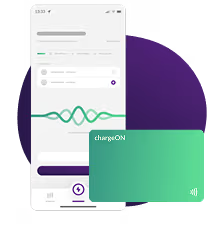chargeFleet: The control center for fleet managers
With chargeFleet, you can keep an eye on your e-fleet at all times and manage it efficiently. Our user-friendly web portal offers full cost transparency and makes it easier to manage authorizations, charging costs and energy consumption at charging stations. It also enables easy organization of charging card and user management for smooth operation.
Detailed overview of all charging processes and analyses of the fleet's charging behavior
User and charge card management
Access management, tariff planning and management of charging stations in the store
The best solution for your drivers too
The proven app offers drivers complete transparency of all charging transactions, including tax-compliant receipts directly in the app. If necessary, the driver can individually expand the app with an RFID charging card, which is particularly practical in areas with poor network coverage, such as underground car parks.
Easy to use app for drivers
Easy to find the available public, private or company-owned charging stations including price information via app
Ability to charge without a physical card with direct billing to the company
Verfügbare Ladestationen
Auf dieser Karte sehen sie alle öffentlich verfügbaren Ladestationen in ganz Europa. Mit dieser Abdeckung garantieren Sie ihren Fahrern einen zuverlässigen Begleiter für öffentliches Laden egal wo sie sich gerade befinden.
An overview of our solutions
chargeHome
For charging via an intelligent & offline wallbox or via a conventional household power outlet. Automatic setting of electricity tariffs by address and zip code.
chargeStation
For managing your own charging stations and controlling the user base as well as corresponding charging rates.
chargePublic
For flexible and convenient charging in public spaces — in Switzerland and Europe.
FAQs
If your question is not answered here, you can contact us directly.
The app allows drivers to find available charging stations, including price information and charging method. The search is easy and the results are clearly structured in the app on the homepage.
Fleet managers receive a central overview of all charging processes, can manage users and driver apps, and use clear statistics to monitor and control charging processes.
Yes, charging can be done via the app without a physical card. As an option, the driver can also use an RFID charging card, which is particularly practical in areas with weak network coverage, such as underground car parks.
To determine a fair price for charging your electric vehicle, you need to consider a few factors. First, you should check the cost per kilowatt hour (kWh) of electricity in your area. You can usually find this information on your electricity provider's website or by contacting them directly. You should also factor in any additional fees or membership costs associated with using a specific charging network or charging station. Finally, you should also consider the convenience and accessibility of the charging station in relation to your charging needs. By considering these factors, you can make an informed decision about fair prices for charging your electric vehicle.
The ideal temperature range for charging your electric vehicle is usually between 10°C (50°F) and 30°C (86°F). Charging within this range helps to maintain optimal battery performance and extend its lifespan. Extreme temperatures, whether hot or cold, can have a negative impact on battery performance and overall condition. If you live in an area with extreme temperatures, you should charge your electric vehicle at milder times of day or, if available, use air-conditioned charging stations.
A home charging station, also known as a home EV charger or wallbox, is a device that allows you to conveniently charge your electric vehicle at home. It is usually installed in your garage or at an outdoor location near your home.
More about charging

Energy and mobility: Bringing together what belongs together

Swisscom optimizes e-mobility management with autoSense fleetCharge




